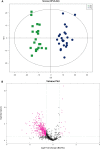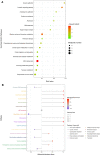Seminal plasma metabolomics and lipidomics profiling to identify signatures of pituitary stalk interruption syndrome
- PMID: 35841106
- PMCID: PMC9287950
- DOI: 10.1186/s13023-022-02408-4
Seminal plasma metabolomics and lipidomics profiling to identify signatures of pituitary stalk interruption syndrome
Abstract
Background: Pituitary stalk interruption syndrome (PSIS) is a rare disease caused by congenital pituitary anatomical defects. The underlying mechanisms remain unclear, and the diagnosis is difficult. Here, integrated metabolomics and lipidomics profiling were conducted to study the pathogenesis of PSIS.
Methods: Twenty-one patients with PSIS (BD group) and twenty-three healthy controls (HC group) were enrolled. Basal information and seminal plasma samples were collected. Untargeted metabolomics and lipidomics analyses were performed using ultraperformance liquid chromatography-quadrupole time-of-flight mass spectrometry (UPLC-QTOF-MS).
Results: The metabolomics and lipidomics profiles of patients with PSIS changed. The prolactin signaling pathway and biosynthesis of amino acids were the main differentially modified metabolic pathways. The main differentially modified metabolites were triacylglycerols (TGs), phosphatidylethanolamine (PE), sphingomyelin (SM), ceramide (Cer) and phosphatidylcholines (PCs). Pregnenolones and L-saccharopine could achieve a diagnosis of PSIS.
Conclusions: Pregnenolones and L-saccharopine are potential biomarkers for a PSIS diagnosis.
Keywords: Biomarker; Lipidomics; Metabolomics; Pituitary stalk interruption syndrome; Rare disease.
© 2022. The Author(s).
Conflict of interest statement
The authors declare that they have no competing interests.
Figures






Similar articles
-
Seminal Plasma Lipidomics Profiling to Identify Signatures of Kallmann Syndrome.Front Endocrinol (Lausanne). 2021 Jul 29;12:692690. doi: 10.3389/fendo.2021.692690. eCollection 2021. Front Endocrinol (Lausanne). 2021. PMID: 34393999 Free PMC article.
-
Seminal plasma metabolomics signatures of normosmic congenital hypogonadotropic hypogonadism.Heliyon. 2023 Mar 23;9(4):e14779. doi: 10.1016/j.heliyon.2023.e14779. eCollection 2023 Apr. Heliyon. 2023. PMID: 37025907 Free PMC article.
-
Integrated gas chromatography-mass spectrometry and ultra-high-performance liquid chromatography-mass spectrometry renal metabolomics and lipidomics deciphered the metabolic regulation mechanism of Gushudan on kidney-yang-deficiency-syndrome rats.J Sep Sci. 2023 Jul;46(13):e2300124. doi: 10.1002/jssc.202300124. Epub 2023 May 2. J Sep Sci. 2023. PMID: 37070550
-
Pituitary Stalk Interruption Syndrome: From Clinical Findings to Pathogenesis.J Neuroendocrinol. 2017 Jan;29(1). doi: 10.1111/jne.12451. J Neuroendocrinol. 2017. PMID: 27917547 Review.
-
Enantioselectivity Effects in Clinical Metabolomics and Lipidomics.Molecules. 2021 Aug 28;26(17):5231. doi: 10.3390/molecules26175231. Molecules. 2021. PMID: 34500665 Free PMC article. Review.
Cited by
-
Pulsatile gonadotropin-releasing hormone therapy induces spermatogenesis in pituitary stalk interruption syndrome: A case report and review of the literature.World J Clin Cases. 2024 Jul 16;12(20):4348-4356. doi: 10.12998/wjcc.v12.i20.4348. World J Clin Cases. 2024. PMID: 39015932 Free PMC article.
-
Lipidomics random forest algorithm of seminal plasma is a promising method for enhancing the diagnosis of necrozoospermia.Metabolomics. 2024 May 21;20(3):57. doi: 10.1007/s11306-024-02118-x. Metabolomics. 2024. PMID: 38773045 Free PMC article.
References
-
- Wang CZ, Guo LL, Han BY, Su X, Guo QH, Mu YM. Pituitary stalk interruption syndrome: from clinical findings to pathogenesis. J Neuroendocrinol. 2017;29(1). - PubMed
Publication types
MeSH terms
LinkOut - more resources
Full Text Sources

